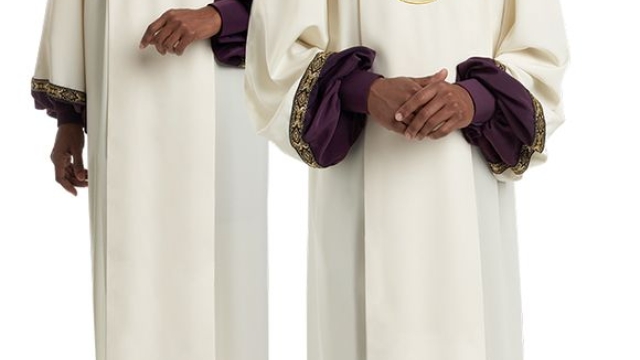
The Harmonious History and Modern Elegance of Choir Robes

Choir robes have long played a significant role in the history of vocal music, creating a visual harmony that complements the melodies and harmonies produced by a singing ensemble. These elegant garments have evolved over time, adapting to the fashion trends and sensibilities of different eras, while still maintaining their traditional essence. From their humble origins as simple garments to their modern-day designs, choir robes continue to inspire a sense of unity and reverence among singers, enhancing their performances and creating a cohesive visual identity.
Throughout history, choir robes have served a practical purpose, allowing singers to perform collectively while highlighting their individual talents. Originally, these robes were plain in design, symbolizing modesty and humility. Over time, however, the robes began to incorporate more intricate details, reflecting the artistic and cultural influences of the times. Today, choir robes come in a variety of styles, colors, and fabrics, encompassing both traditional and contemporary aesthetics and catering to the diverse needs and preferences of choirs worldwide.
Beyond their functional and aesthetic qualities, choir robes also carry a deeper symbolism. When worn, they create a unifying presence that bridges the gap between the past and present, connecting singers with a rich legacy of musical traditions. Regardless of the era or specific design, the act of adorning a choir robe signifies a shared commitment to the music, as well as a respect for the history and spirituality surrounding vocal performances. In this sense, choir robes become more than just garments; they become vessels of tradition, unity, and reverence for the art of choral singing.
As we delve into the harmonious history and modern elegance of choir robes, we unravel the threads that have woven these garments into the tapestry of musical culture. Exploring the evolution of their design and understanding their symbolic significance, we witness how choir robes not only enhance the visual aspect of a performance but also contribute to the collective experience of singing together, creating a sense of harmony that extends beyond the melodies and lyrics. It is this unique blend of tradition, style, and unity that continues to make choir robes an integral part of choral music, captivating both performers and audiences alike.
The Evolution of Choir Robes
Choir robes have a rich and fascinating history that spans centuries. Over time, these elegant garments have evolved in style and purpose, reflecting the changing trends and traditions of choral music. From their humble origins to their modern-day significance, choir robes continue to be an integral part of the choral experience.
In the early days, choir robes were simple and practical. They served primarily as a way to unify the singers and create a sense of equality among them. Often made of plain materials such as linen or wool, these robes were designed to be functional rather than ornate. The focus was on creating a cohesive look and ensuring that the attention remained on the music rather than the individuals wearing the robes.
As choral music gained popularity and became more closely associated with religious ceremonies, choir robes began to take on a more symbolic role. They became a visual representation of the sacredness and solemnity of the music being performed. In this era, choir robes started featuring intricate designs and embellishments, often incorporating religious symbols or motifs. The shift towards more elaborate robes emphasized the reverence and spirituality of the choral experience.
In the modern era, choir robes have continued to evolve, adopting a more contemporary and stylish aesthetic. While still retaining their traditional elements, such as flowing robes and distinctive colors, they now often feature modern fabrics and streamlined designs. This merging of tradition and innovation allows choirs to showcase their professionalism and adapt to the evolving tastes of audiences. The evolution of choir robes serves as a testament to the enduring significance of choral music and the desire to strike a harmonious balance between tradition and modernity.
Symbolism and Tradition of Choir Robes
Choir robes hold a deep significance within the realm of choral music, embodying a rich tradition that has withstood the test of time. These elegant garments not only serve a practical purpose but also carry symbolic meaning, creating a sense of unity and reverence among choir members.
The pure white color of most choir robes is often associated with purity and spiritual devotion. It represents a collective commitment to strive for musical excellence while uplifting the spirits of both the performers and the audience. This symbolism reinforces the notion that music, particularly vocal harmonies, has the power to transcend our earthly existence and connect us to realms beyond.
In addition to their symbolic color, choir robes are carefully designed to create a sense of cohesion among the singers. The uniformity of style and appearance removes individual distinctions, allowing the focus to shift solely to the collective sound. By donning these robes, choir members become part of a greater whole, merging their unique voices into a harmonious blend of musical expression.
https://www.choirbuy.com/collections/choir-robes
Throughout history, choir robes have served as a visual representation of the choir’s role within religious and ceremonial contexts. Whether performed in grand cathedrals or humble chapels, the choir holds a significant presence within these spaces. The robes not only reflect the importance of the choral music being sung but also elevate the spiritual atmosphere, adding a touch of ceremonial grandeur.
In conclusion, choir robes encompass both a rich symbolism and a deep tradition within the world of choral music. Their white color represents purity and spiritual devotion, while their uniform design fosters unity among singers. Additionally, these robes hold historical and ceremonial significance, signifying the role of the choir within religious and formal settings. As modern elegance meets timeless tradition, choir robes continue to enhance the beauty and power of choral performances.
Contemporary Designs and Styles of Choir Robes
Choir robes have evolved over time, embracing contemporary designs and styles that add a touch of modern elegance to choir performances. These new designs have breathed new life into the traditional attire, making choir robes not only functional but also aesthetically pleasing.
The modern styles of choir robes showcase a variety of cuts and silhouettes that cater to different body types and personal preferences. From classic flowing gowns to sleek tailored robes, there is a design to suit every choir member. These contemporary styles ensure that choir members feel comfortable and confident while performing, allowing them to focus on their musical prowess.
In addition to the various cuts, choir robes now come in a wide array of colors and fabrics. While the traditional black robes still hold their timeless allure, choirs now have the option to experiment with vibrant hues and rich tones. These colorful robes bring a visual element to the performance, enhancing the overall aesthetic appeal.
Furthermore, modern choir robes often feature intricate details and embellishments. Delicate embroidery, beading, and appliques can be found adorning the robes, adding an exquisite touch. These artistic accents not only elevate the visual appeal but also reflect the choir’s unique identity and style.
In conclusion, contemporary designs and styles have transformed choir robes into more than just functional garments. The harmonious combination of cuts, colors, fabrics, and embellishments has brought a fresh elegance to the tradition of wearing choir robes. Today, choirs have the freedom to express their individuality and showcase their modern flair while maintaining the symbolic significance of this iconic attire.



